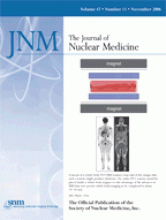TO THE EDITOR: The findings of Prévost et al. (1) on bone marrow standardized uptake value (SUV) as a survival predictor in lung cancer are interesting. The authors substituted a height (H) algorithm for the customarily used body weight (W) to calculate the SUV in the case of bone marrow. This substitution made it possible to find a statistical significance that supports the conclusions of this investigation. However, tumor SUV was calculated with the traditional W.
The literature shows W substitution algorithms falling into the following classes of functional dependencies:
Ideal body weight: f(H, sex) (2);
Lean body mass: f(W, H, sex) (3);
Geometric body surface area: f(W, H) (4);
18F-FDG-tissue body surface area: f(W, H optionally, tissue class) (7).
For bone marrow, the authors tried an incorrect adaptation of the first algorithm. They selected the algorithm for the female ideal body weight (sometimes called lean body mass, as the authors here preferred) used in a study of females (2) instead of using separate expressions for males and females. Criticism (3) of the ideal-body-weight approach for correcting SUVs compared with the usual uses of lean body mass or body surface area has led to data reevaluation. The conclusions of Prevost et al. (1) may have remained unchanged had other choices for W replacement been made, noting that the ratio of bone marrow to liver (traditionally a ratio of uncorrected activity densities) was found to be a significant survival predictor. However, especially considering the rather noticeable effect of age on liver SUV (using W or presumably also a W substitute) (8), use of the liver as a reference may require additional considerations. In contrast to the SUV increasing with age for the liver, it was recently reported that SUV decreases with age for bone marrow (9). Could the healthy group be younger than the cancer patients?
Sixteen markers are examined for statistical significance to predict survival. These 16 (and perhaps others investigated and not reported) are somewhat large in number. Thus, the statistical issue of multiple comparisons arises. If addressed, this issue might change opinions about the significance of some markers.
Perhaps not generally appreciated is the possibility of certain tissue classes, in the case of 18F-FDG, for which a traditional SUV (i.e., using W rather than a W substitute) is preferable. Normal bone marrow in females has been reported to be such a class (2): Its traditional SUV had no trend with W in this population and so would be the correct approach. Zasadny et al. (2) also demonstrated that using the inappropriate ideal body weight in the SUV (i.e., the approach of Prevost et al. (1) here for bone marrow) led to an undesirable significant inverse correlation between such a corrected SUV and increased weight.
The above 5 classes are in approximate order of their capabilities to reduce the variability encountered in 18F-FDG traditional SUVs caused by the fat portion of body weight. Fat, differing from patient to patient, is low in 18F-FDG uptake. Classes 4 and 5 are optimal in that they find parameters to improve on the geometric body-surface-area algorithm in order to minimize population variability in 18F-FDG SUVs that result from using these parameters. It is interesting to speculate on the multitude of 18F-FDG investigations to date: whether some missed discovering statistically significant effects because of a commonplace failure to implement improved SUV calculations, which, to their credit, the authors recognized as something to try here for bone marrow.
In general, it is possible to predict when it can be worthwhile to substitute for W in SUV calculations. The coefficient of variation of weights encountered in populations is typically approximately 0.15. The residual influence of this parameter on the traditionally calculated SUV is not linear because of a fractional-power-law effect (7), and SUVs, if there were no other influences, would thereby have coefficients of variation of approximately 0.1. In practice, however, traditionally calculated SUVs also have various (mostly physiologic) influencing factors. When these lead to SUV coefficients of variation not greatly exceeding approximately 0.1, it can be worthwhile to replace W (such as by fractional-power-law body-surface-area algorithms) and reduce variability for most tissues.
A good point made by the authors is that additional studies are needed to understand factors associated with 18F-FDG uptake in the bone marrow of cancer patients. If these studies are done, consideration could also be given to more intensive analysis of weight, height, and age influences on various tissue SUVs in both patients with cancer and patients without cancer. Evidence has already been presented and commented on (2) that because of the fat content of bone marrow, its traditional SUV does not exhibit the same population behavior with W as that of other tissues. Thus, an appropriate SUV calculation for the bone marrow of patients with cancer and patients without cancer might use different parameters than were used by the authors here or than appear in reports of the above 5 classes. Ideally, dynamic scans might be added to the list of additional studies to shed light on bone marrow quantification issues—a methodology already demonstrated as useful in SUV algorithm development (6). Dynamic scans separate out the confounding factor of the blood input function, which is known to be responsible for anthropometric influences on SUVs (5). Then, the bone marrow rate constants obtained in this manner have the potential to provide fundamental insights.
Footnotes
-
COPYRIGHT © 2006 by the Society of Nuclear Medicine, Inc.







